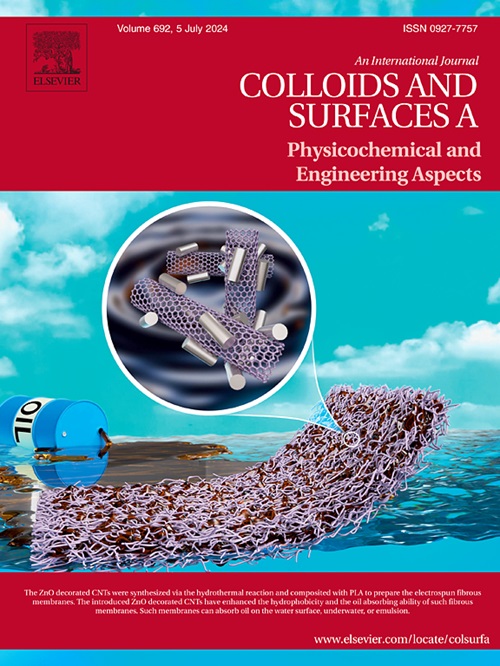Competitive adsorption and gas diffusion inhibition effect between long-chain alcohol and short-chain fluorocarbon surfactant in foam solution
IF 5.4
2区 化学
Q2 CHEMISTRY, PHYSICAL
Colloids and Surfaces A: Physicochemical and Engineering Aspects
Pub Date : 2025-07-17
DOI:10.1016/j.colsurfa.2025.137777
引用次数: 0
Abstract
Long-chain alcohols offer remarkable potential for foam stabilization due to their biocompatibility and amphiphobic characteristics. However, their impact on fluorocarbon surfactant systems remains insufficiently explored. This study chose 1-octanol, 1-decanol, and 1-dodecanol as stabilizers, investigating their effects on surface activity, interfacial activity, spreading performance, viscosity, bubble evolution, and drainage property in foam solution containing short-chain fluorocarbon surfactant. The result indicates that long-chain alcohols competitively displace surfactants at interfaces, reducing surface and interfacial activities. Meanwhile, interfacial alcohol adsorption elevates surfactant concentration in aqueous phase, promoting surfactant/alcohol micellization and increasing viscosity. 1-Dodecanol, with high hydrophobicity, triggers phase separation above 3 mmol/L, inducing the highest viscosity elevation. Long-chain alcohols exert dual effects on bubble evolution, with critical concentrations (1-octanol: 3 mmol/L, 1-decanol: 1 mmol/L, 1-dodecanol: 1 mmol/L) serving as thresholds. At or below these thresholds, interfacial alcohol adsorption and synergistic micellization strengthen foam films and inhibit gas diffusion, retarding bubble coarsening. Above thresholds, excessive alcohols accelerate bubble rupture. The drainage analysis reveals that 1-octanol and 1-decanol effectively stabilize foam through viscosity enhancement and coarsening inhibition, while 1-dodecanol exacerbates foam drainage and destabilization. The foam solution with 3 mmol/L 1-octanol exhibits the optimal characteristics, with a surface tension of 22.00 mN/m, 25 % drainage time of 61.83 s, and spreading coefficients of 4.27 mN/m with diesel and 3.28 mN/m with cyclohexane. This study provides references for the application of long-chain alcohols as foam stabilizers in fluorocarbon surfactant systems, establishing a foundation for developing environmentally friendly aqueous film-forming foam.
长链醇与短链氟碳表面活性剂在泡沫溶液中的竞争吸附和气体扩散抑制作用
由于其生物相容性和双疏性,长链醇具有显著的泡沫稳定潜力。然而,它们对氟碳表面活性剂系统的影响尚未得到充分探讨。本研究选择1-辛醇、1-癸醇和1-十二醇作为稳定剂,考察了它们在含短链氟碳表面活性剂的泡沫溶液中对表面活性、界面活性、铺展性能、粘度、气泡演化和排水性能的影响。结果表明,长链醇在界面处竞争性地取代表面活性剂,降低了表面和界面活性。同时,界面醇吸附提高了表面活性剂在水相中的浓度,促进了表面活性剂与醇的胶束作用,增加了粘度。1-十二醇具有较高的疏水性,在3 mmol/L以上引发相分离,引起最高的粘度升高。长链醇对气泡演化具有双重影响,临界浓度(1-辛醇:3 mmol/L, 1-癸醇:1 mmol/L, 1-十二醇:1 mmol/L)作为阈值。当达到或低于这些阈值时,界面酒精吸附和协同胶束作用增强泡沫膜,抑制气体扩散,延缓气泡粗化。超过阈值,过量的酒精会加速气泡破裂。排液分析表明,1-辛醇和1-癸醇通过增粘和抑制粗化作用有效稳定泡沫,而1-十二醇则加剧了泡沫的排液和失稳。1-辛醇浓度为3 mmol/L的泡沫溶液表现出最佳的特性,其表面张力为22.00 mN/m,滤出时间为25 %,滤出时间为61.83 s,柴油和环己烷的扩散系数分别为4.27 mN/m和3.28 mN/m。本研究为长链醇作为泡沫稳定剂在氟碳表面活性剂体系中的应用提供了参考,为开发环保型水性成膜泡沫奠定了基础。
本文章由计算机程序翻译,如有差异,请以英文原文为准。
求助全文
约1分钟内获得全文
求助全文
来源期刊
CiteScore
8.70
自引率
9.60%
发文量
2421
审稿时长
56 days
期刊介绍:
Colloids and Surfaces A: Physicochemical and Engineering Aspects is an international journal devoted to the science underlying applications of colloids and interfacial phenomena.
The journal aims at publishing high quality research papers featuring new materials or new insights into the role of colloid and interface science in (for example) food, energy, minerals processing, pharmaceuticals or the environment.

 求助内容:
求助内容: 应助结果提醒方式:
应助结果提醒方式:


